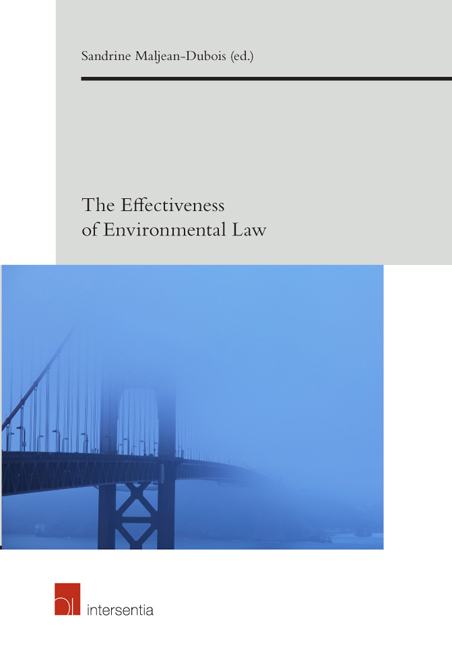Book contents
- Frontmatter
- Preface
- Contents
- Introduction. The Effectiveness of Environmental Law: A Key Topic
- Part 1 Measuring and Assessing Effectiveness
- Chapter 1 The Climate Resilience of Critical Infrastructural Network Sectors. An Interdisciplinary Method for Assessing Formal Responsibilities for Climate Adaptation in Critical Infrastructural Network Sectors
- Part 2 Improving Effectiveness
- Better Legislation
- Better Implementation
Chapter 1 - The Climate Resilience of Critical Infrastructural Network Sectors. An Interdisciplinary Method for Assessing Formal Responsibilities for Climate Adaptation in Critical Infrastructural Network Sectors
from Part 1 - Measuring and Assessing Effectiveness
Published online by Cambridge University Press: 27 September 2018
- Frontmatter
- Preface
- Contents
- Introduction. The Effectiveness of Environmental Law: A Key Topic
- Part 1 Measuring and Assessing Effectiveness
- Chapter 1 The Climate Resilience of Critical Infrastructural Network Sectors. An Interdisciplinary Method for Assessing Formal Responsibilities for Climate Adaptation in Critical Infrastructural Network Sectors
- Part 2 Improving Effectiveness
- Better Legislation
- Better Implementation
Summary
ABSTRACT
This chapter presents and applies an interdisciplinary (law & governance) method for the assessment of the climate resilience of critical infrastructural network sectors. Broadly applicable, this methodological framework comprises three phases, within which six logically arranged steps are set out. The central assessment criterion for climate resilience, the ‘expected effectiveness’ of responsibilities for climate adaptation, is operationalized through six indicators. These are: awareness, proactivity, appropriateness, explicitness, transparency and legitimacy. Apart from academic purposes, this assessment framework can prove useful to law and policy makers in assessing and (re)developing the relevant arrangements that govern critical infrastructural network sectors. To give examples of the functioning of the assessment framework, this framework is applied in two case studies that address the Dutch electricity and internet sectors. These case studies show a rather low level of expected effectiveness of responsibilities for climate adaptation in both sectors. Apart from their exemplary purpose, these case studies provide insights into potential pitfalls which can be relevant for increasing the climate resilience of other network sectors in the Netherlands, in other EU Member States and abroad.
INTRODUCTION
Modern societies and key societal functions, such as emergency management and health care, depend largely upon the smooth-functioning of critical infrastructural networks, such as energy, ICT, drinking water and transportation networks. The collapse of such networks can cause an array of societal disruption and damage. Critical infrastructural networks are particularly prone to external influences, such as floods and other water-related events. The expected climate change increases the chance of such events, thus also increasing the infrastructural networks’ vulnerability. International, EU and domestic climate change scenarios display rather clear trends. Focusing on the EU and its Member States, increases in the duration, probability and intensity of weather extremes (e.g. heavy rainfall and extreme droughts) are already being perceived throughout the continent and are expected to increase even further. The associated risks, in this chapter, are referred to as climate risks. The question arises how the responsibilities to combat climate risks for critical infrastructural networks are divided in the EU and in its Member States particularly, and to what extent these responsibilities, and the division thereof, are expected to be effective.
- Type
- Chapter
- Information
- The Effectiveness of Environmental Law , pp. 15 - 36Publisher: IntersentiaPrint publication year: 2017



